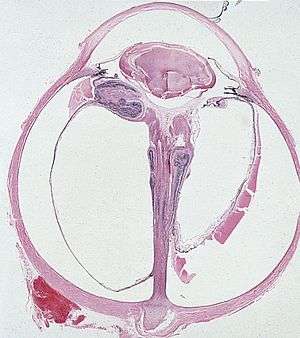Persistent hyperplastic primary vitreous
Persistent hyperplastic primary vitreous (PHPV), also known as persistent fetal vasculature (PFV), is a rare congenital developmental anomaly of the eye that results following failure of the embryological, primary vitreous and hyaloid vasculature to regress.[1] It can be present in three forms: purely anterior (persistent tunica vasculosa lentis and persistent posterior fetal fibrovascular sheath of the lens), purely posterior (falciform retinal septum and ablatio falcicormis congenita) and a combination of both.[1] Most examples of PHPV are unilateral and non-hereditary. When bilateral, PHPV may follow an autosomal recessive or autosomal dominant inheritance pattern.
| Persistent hyperplastic primary vitreous | |
|---|---|
| Other names | Congenital retinal detachment, Non-syndromic congenital retinal non-attachment |
 | |
| Falciform fold of detached dysplastic retina encircles the persistent hyaloid artery that extends from the optic nerve head to the retrolental mass. | |
| Specialty | Ophthalmology |
Symptoms
The primary vitreous used in formation of the eye during fetal development remains in the eye upon birth and is hazy and scarred.[2] The symptoms are leukocoria, strabismus, nystagmus and blurred vision, blindness.[3]
Causes
- Trisomy 13 (Patau syndrome)
- Norrie disease
- Walker-Warburg syndrome
- Autosomal dominant
- Autosomal recessive
Diagnosis
Causes a 'white reflex' in the affected eye (leukocoria), prompting further investigation.
Treatment
Pars plana lensectomy and vitrectomy
See also
References
- Silbert, Mira; Gunvood, Andrew S. (2000). "Clinical review, Persistent hyperplastic primary vitreous". Clinical Eye and Vision Care. Ireland: Elsevier Science Ireland Ltd. 12 (3–4): 131–137. doi:10.1016/S0953-4431(00)00054-0. PMID 11137427.
- Young, Jane. "Persistent Hyperplastic Primary Vitreous". Archived from the original on 2017-12-12. Retrieved 2009-05-11.
- "Persistent Hyperplastic Primary Vitreous (PHPV)". www.ssc.education.ed.ac.uk. Retrieved 2016-09-19.
External links
| Classification | |
|---|---|
| External resources |